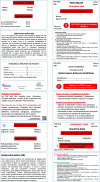Emergency management in epidermolysis bullosa: consensus clinical recommendations from the European reference network for rare skin diseases
- PMID: 32505191
- PMCID: PMC7276067
- DOI: 10.1186/s13023-020-01403-x
Emergency management in epidermolysis bullosa: consensus clinical recommendations from the European reference network for rare skin diseases
Abstract
Epidermolysis bullosa (EB) comprises a group of genetic disorders with the hallmark of fragility of the skin and mucosal surfaces. The severity of different types of EB varies markedly as does the occurrence of extra-cutaneous involvement and complications. A number of emergency situations may occur in the context of EB including obstruction to oral intake from oral or esophageal blisters or scarring, acute airway obstruction, acute urinary retention, sepsis and corneal erosions. Whilst general management principles apply in each of these settings, specific considerations are essential in managing EB to avoid undue trauma or damage to delicate tissues. These recommendations have been developed from a literature review and consensus from experts of the European Network for Rare Skin Disorders (ERN-Skin) to aid decision-making and optimize clinical care by non-EB expert health professionals encountering emergency situations in babies, children and adults with EB.
Keywords: Airway obstruction; Blister; Corneal erosion; ERN-skin; Epidermolysis bullosa; Esophageal obstruction; Pain; Sepsis; Urinary retention.
Conflict of interest statement
The authors declare that they have no competing interests.
Figures
Similar articles
-
Practical management of epidermolysis bullosa: consensus clinical position statement from the European Reference Network for Rare Skin Diseases.J Eur Acad Dermatol Venereol. 2021 Dec;35(12):2349-2360. doi: 10.1111/jdv.17629. Epub 2021 Sep 21. J Eur Acad Dermatol Venereol. 2021. PMID: 34545960
-
Multicentre consensus recommendations for skin care in inherited epidermolysis bullosa.Orphanet J Rare Dis. 2014 May 20;9:76. doi: 10.1186/1750-1172-9-76. Orphanet J Rare Dis. 2014. PMID: 24884811 Free PMC article. Review.
-
Eye Involvement and Management in Inherited Epidermolysis Bullosa.Drugs. 2022 Aug;82(12):1277-1285. doi: 10.1007/s40265-022-01770-8. Epub 2022 Sep 8. Drugs. 2022. PMID: 36074321 Review.
-
Consensus reclassification of inherited epidermolysis bullosa and other disorders with skin fragility.Br J Dermatol. 2020 Oct;183(4):614-627. doi: 10.1111/bjd.18921. Epub 2020 Mar 11. Br J Dermatol. 2020. PMID: 32017015 Review.
-
[Syndromes 13. Epidermolysis bullosa].Ned Tijdschr Tandheelkd. 1999 Aug;106(8):302-5. Ned Tijdschr Tandheelkd. 1999. PMID: 11930425 Review. Dutch.
Cited by
-
Epidermolysis Bullosa in children: the central role of the pediatrician.Orphanet J Rare Dis. 2022 Apr 4;17(1):147. doi: 10.1186/s13023-021-02144-1. Orphanet J Rare Dis. 2022. PMID: 35379269 Free PMC article.
-
The C4EB study-Transvamix (10% THC / 5% CBD) to treat chronic pain in epidermolysis bullosa: A protocol for an explorative randomized, placebo controlled, and double blind intervention crossover study.PLoS One. 2022 Dec 12;17(12):e0277512. doi: 10.1371/journal.pone.0277512. eCollection 2022. PLoS One. 2022. PMID: 36508401 Free PMC article.
-
Hologene 5: A Phase II/III Clinical Trial of Combined Cell and Gene Therapy of Junctional Epidermolysis Bullosa.Front Genet. 2021 Sep 1;12:705019. doi: 10.3389/fgene.2021.705019. eCollection 2021. Front Genet. 2021. PMID: 34539738 Free PMC article.
-
Epidermolysis Bullosa: Two rare case reports of COL7A1 and EBS-GEN SEV KRT14 variants with review of literature.BMC Pediatr. 2024 Apr 5;24(1):242. doi: 10.1186/s12887-024-04715-0. BMC Pediatr. 2024. PMID: 38580989 Free PMC article. Review.
-
Taking care of patients with recessive dystrophic epidermolysis bullosa from birth to adulthood: a multidisciplinary Italian Delphi consensus.Orphanet J Rare Dis. 2025 Mar 16;20(1):128. doi: 10.1186/s13023-025-03635-1. Orphanet J Rare Dis. 2025. PMID: 40091088 Free PMC article.
References
Publication types
MeSH terms
LinkOut - more resources
Full Text Sources


